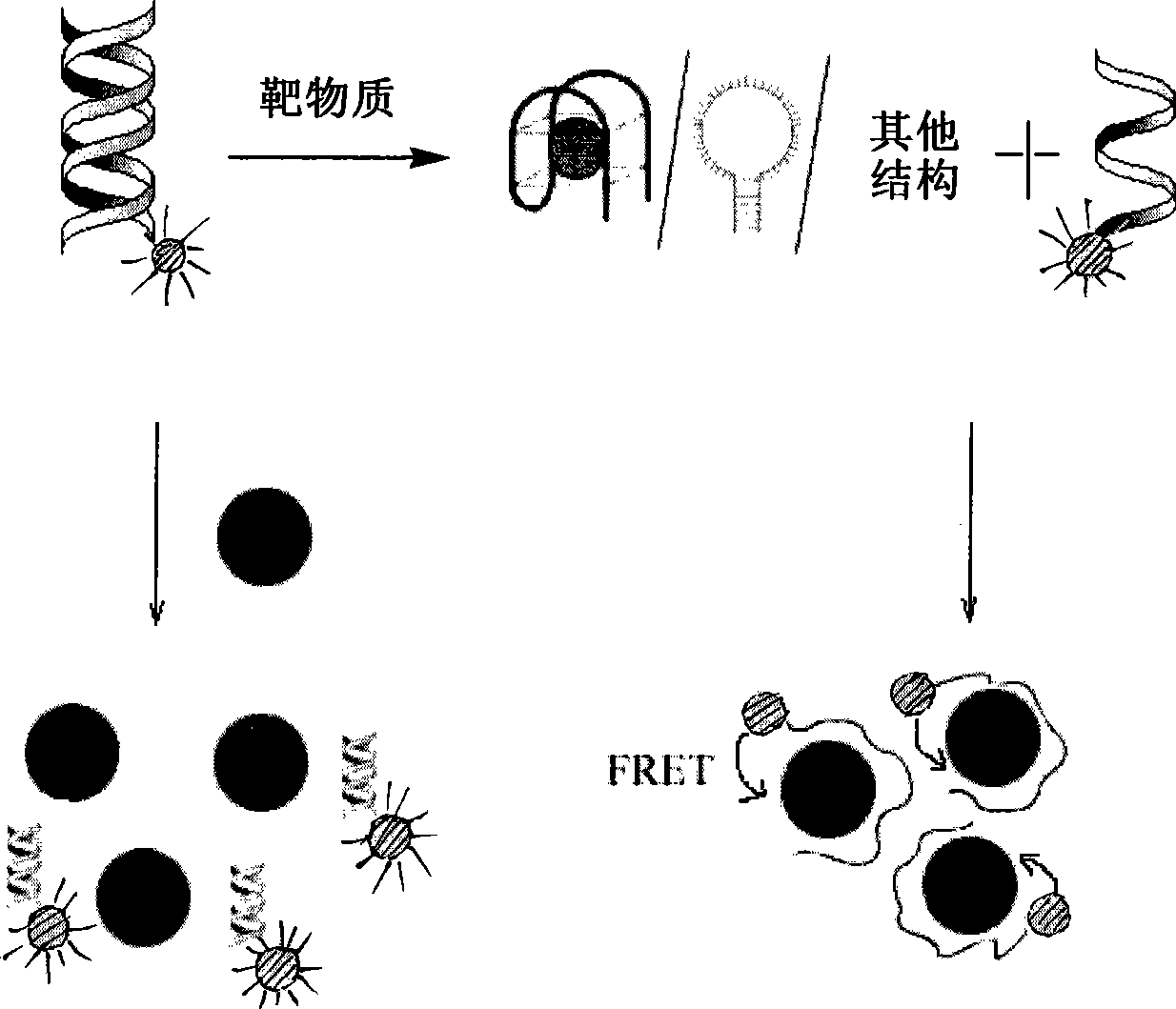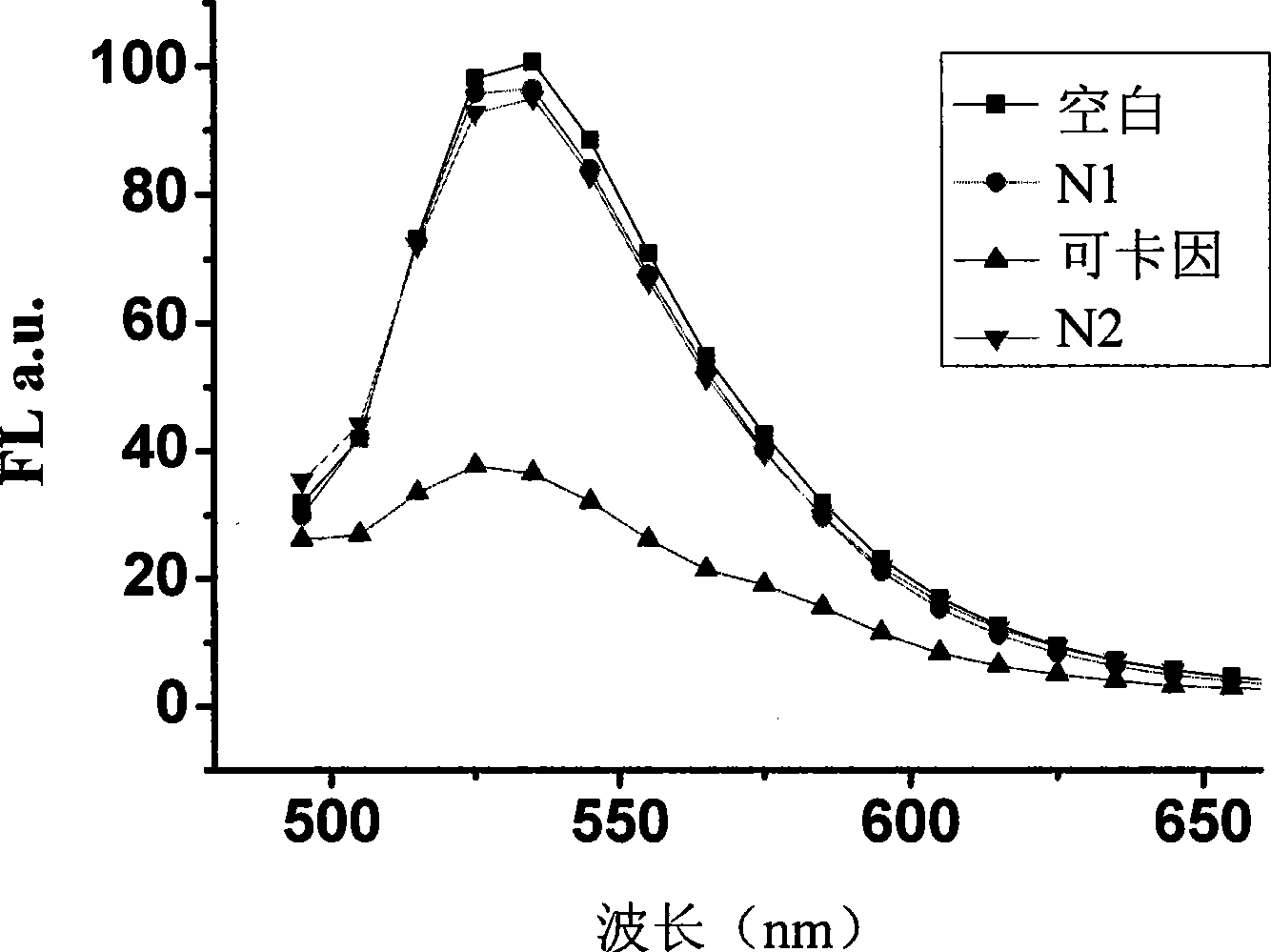Target molecule detecting method based on nanometer aurum and nucleic acid structure
A detection method and technology of target molecules, which are applied in the determination/inspection of microorganisms, biochemical equipment and methods, and analysis through chemical reactions of materials, etc., to achieve the effects of wide application range, rapid detection and high specificity
- Summary
- Abstract
- Description
- Claims
- Application Information
AI Technical Summary
Problems solved by technology
Method used
Image
Examples
Embodiment 1
[0036] Example 1 Detection of cocaine
[0037] Steps: Take 2 μL cocaine aptamer solution with a concentration of 100 μM and 2 μL cDNA solution with a concentration of 100 μM, add 14 μL buffer solution (25 mM Tris, pH 8.2, 0.3 M NaCl), heat to 85 ° C and slowly cool to Allow it to fully hybridize to form double-stranded probes at room temperature. Then, 2 μL of cocaine hydrochloride aqueous solution with a concentration of 0.01-1 mM was added to the hybridization solution, and the mixture was reacted at room temperature for 30 minutes to fully react. At the same time, the group without adding cocaine and adding 2 μL of water was used as a blank, and the two groups of adding 2 μL of 1 mM benzoylecgonine (N1) and ecgonine methyl ester (N2) were used as controls. Then take 2 μL of the above-mentioned reaction solution and add 100 μL of nano-gold solution (13nm, 3.5nM), react for 5min, use the above-mentioned buffer solution (25mM Tris, pH8.2, 0.3M NaCl) to make up the total volum...
Embodiment 2
[0039] The detection of embodiment 2 ATP
[0040] Steps: Take 2 μL of ATP aptamer solution with a concentration of 100 μM and 2 μL of cDNA solution with a concentration of 100 μM, add 14 μL of buffer solution (25 mM Tris, pH 8.2, 0.15 M NaCl), heat to 85 ° C and slowly cool to Allow it to fully hybridize to form double-stranded probes at room temperature. Then, 2 μL of an aqueous solution of ATP with a concentration of 0.01-1 mM was added to the hybridization solution, and the mixture was reacted at room temperature for 30 minutes to fully react. At the same time, a group without adding ATP and adding 2 μL of water was used as a blank, and a group of adding 2 μL of 1 mM CTP, UTP, and GTP was used as a control. Then take 2 μL of the above-mentioned reaction solution and add 100 μL of nano-gold solution (20nm, 1nM), react for 5 minutes, use the above-mentioned buffer solution (25mM Tris, pH8.2, 0.15M NaCl) to make up the total volume of 0.2mL, record the experimental group and...
Embodiment 3
[0042]Example 3 Detection of divalent mercury ions (1)
[0043] Steps: Take 1 μL of MSO solution with a concentration of 1 μM and 1 μL of cDNA solution with a concentration of 1 μM, add 16 μL of buffer solution (10 mM arsine-sodium arsine, pH 6.8, 0.3 M NaCl), and react for 10 minutes at room temperature. It hybridizes sufficiently to form a double-stranded probe. Then add 2 μL of Hg with a concentration of 100 nM to 0.1 mM to the hybridization solution. 2+ aqueous solution, and reacted at room temperature for 5 minutes to make it fully reacted. without adding Hg 2+ , add 2 μL of water to a group as a blank experiment. In addition, selectivity analysis was carried out through two groups of experiments, one group added 2 μL of 25 mM Ca 2+ , Mg 2+ The other group added 0.5mM mixed ions (Fe 2+ , Cu 2+ ,Co 2+ , Mn 2+ , Ni 2+ , Zn 2+ , Cd 2+ ). Then take 5 μL of the above-mentioned reaction solution and add 5 μL of nano-gold solution (10nm, 100nM) respectively, after r...
PUM
 Login to View More
Login to View More Abstract
Description
Claims
Application Information
 Login to View More
Login to View More - R&D Engineer
- R&D Manager
- IP Professional
- Industry Leading Data Capabilities
- Powerful AI technology
- Patent DNA Extraction
Browse by: Latest US Patents, China's latest patents, Technical Efficacy Thesaurus, Application Domain, Technology Topic, Popular Technical Reports.
© 2024 PatSnap. All rights reserved.Legal|Privacy policy|Modern Slavery Act Transparency Statement|Sitemap|About US| Contact US: help@patsnap.com









